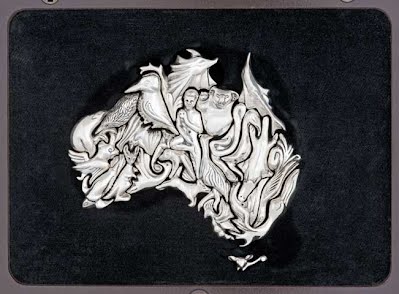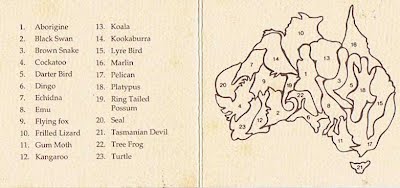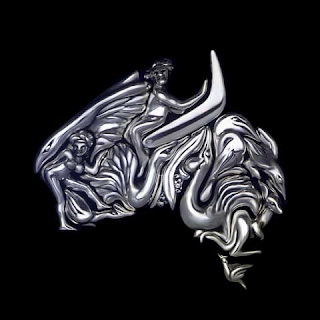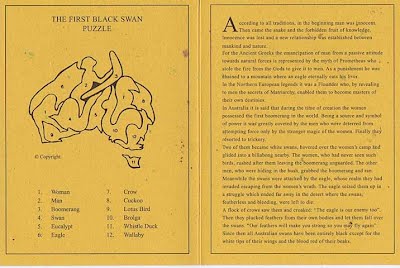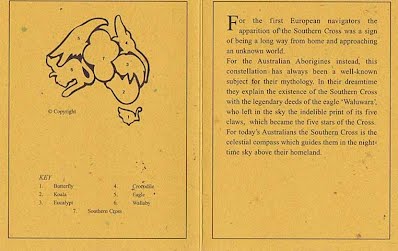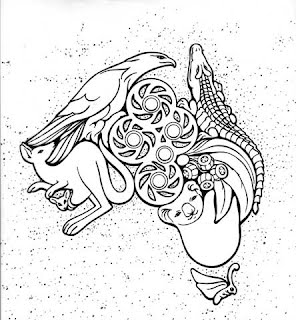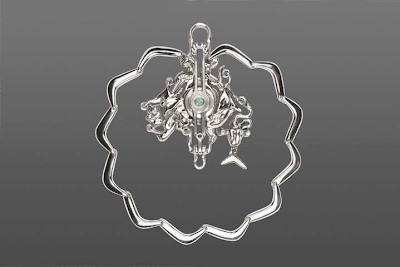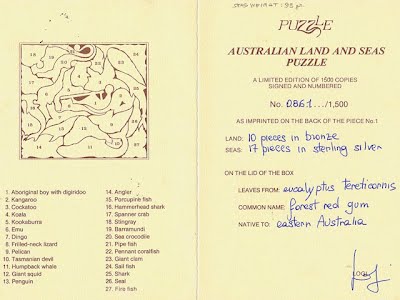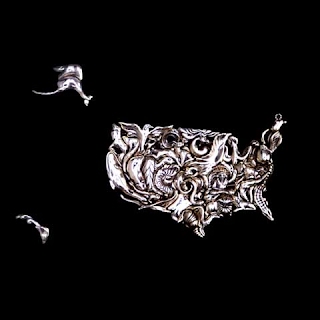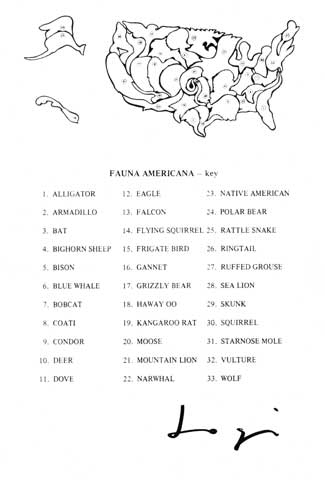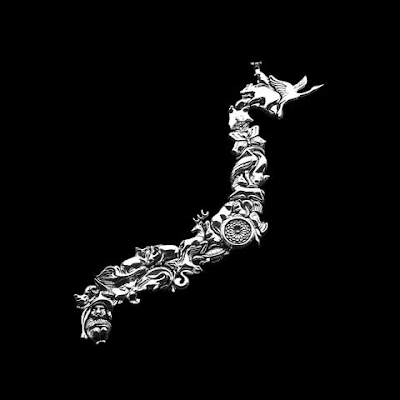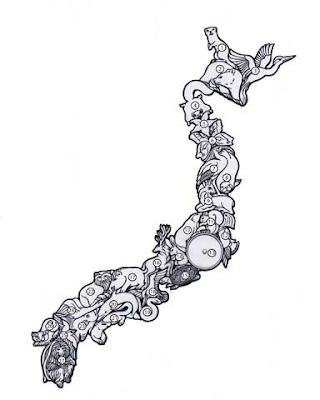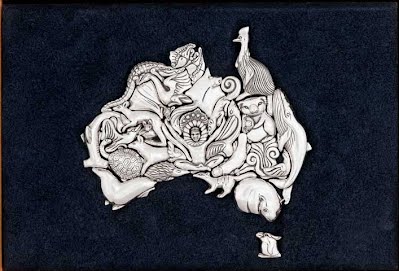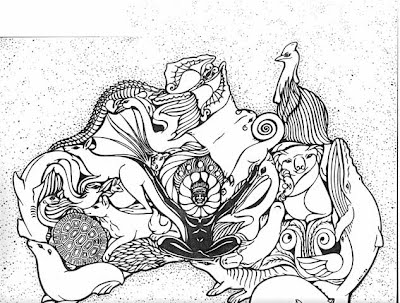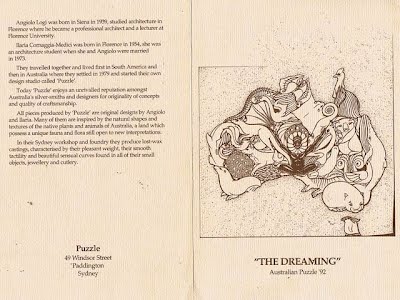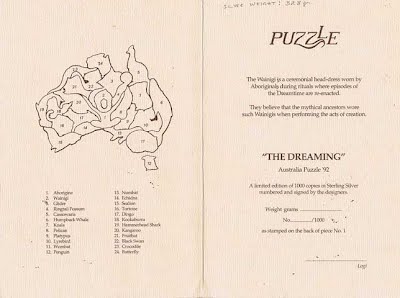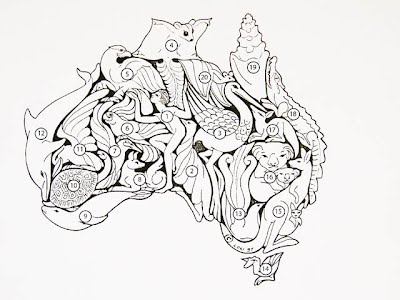Angiolo Logi (1939–), an architect, and his wife, Ilaria Cornaggia Medici (1954–2009), a silversmith, of Sydney, Australia, can be described as major figures in the cluster puzzle genre, in both inherent quality, depth, and longevity. Twelve distinct cluster puzzles, from 1979–2001, are identified, all, without exception, of a country theme, of indigenous animals, and in particular, naturally enough, of Australia, with no less than nine instances, but there are also single instances of Japan, USA and USSR (after visits). These were simply titled by the Logis as ‘Geographic Puzzles’. In short, Angiolo drew the designs, and Ilaria executed them. The Logis have a background in silversmithing, of which the puzzles reflect this medium. After migrating from Florence, Italy, to Australia in 1979, they established the silver workshop, 'Puzzle', in the inner-city suburb of Paddington from which they have made their home ever since. Among their silver artworks in general they have produced, mostly of silver (in limited editions, typically of 1000–1500), a most impressive collection of cluster puzzles. Each puzzle is presented in its own sumptuous box, along with brochures and other enclosures. Everything about this puzzle is pure class! The Logis can be seen to have some reputation in the world of silversmithing, and the price these puzzles command reflect this; at the top end of the market, from $1,650 (Didgeridoo) to $3,250 (Dreaming). Further, the puzzles have been introduced to a celebrity audience, with recipients Her Majesty the Queen, a 60th birthday gift given by Bob Hawke from the people of Australia. More recently the Three Tenors received a puzzle each and SOCOG (Sydney Organising Committee for Olympic Games) presented a puzzle to Athens to congratulate them on their successful Olympic bid. Other notable collectors include Harrison Ford, Michael Jackson and Stevie Wonder. And indeed, Presidents too! A story is told of a passing Mr Gorbachov who was suitably presented with a USSR puzzle upon a Sydney visit (see the press cutting under the USSR entry below). Although the puzzles have been discussed in the Australian popular press, notably in the Sydney Morning Herald and abroad, in the US, for instance in New York Magazine, although this is not perhaps as extensive as may otherwise be thought; some are essentially mere mentions in passing. Further afield, I have not found a single reference in any UK paper or magazine! An natural outlet is of the puzzle world, but so far as I can tell, there is not a single reference in any puzzle journal, worldwide! Possibly this is due to the Logis lack of knowledge of the genre elsewhere, and so they catered to a niche home audience rather than the puzzle community at large. Further, the Logis also have a coffee table book, Australia Puzzle, which shows their work per se, and includes many, but not all, of the puzzles. Again, this book is little known and is anonymous in puzzle circles. However, that said, the puzzles are indeed featured in Australian Museum collections as well as exhibitions. These include the Powerhouse Museum (2003) and Castel Sant’Angelo in Rome (1999). A feature here is the sheer number of puzzles based on the Australian silhouette, with no less than nine! With such a high number, one may think that perhaps the quality would vary, but this isn't so; each is of equally high quality. As can be seen, these are not merely variations of one another but are rather each distinct in their own right. This is thus indicative that the concept of such country puzzles is perhaps easier than may otherwise be thought (not that most people have reflected upon this). Any shortcoming by a would-be designer is therefore not due to the intrinsic difficulty, but rather the lack of imagination on the part of the designer. Therefore, this thus reflects very well indeed on Angiolo. Picking a ‘best’ is an invidious choice; they are all of a high standard. However, if pressed, I would select ‘Land and Sea’, based on Australia, on account that it has one extra, pleasing innovation not shown by other ‘country designers’, in that it also has creatures of the sea surrounding the country. A very nice nuance indeed! Others, notwithstanding the intrinsic quality, by sheer number alone are also impressive, such as the USA and USSR. Indeed, the USA puzzle has a further nuance; not only are the animals indigenous, but also are to be found in their respective regions! Until relatively recently, at least as of 2015, the Logis had their own website, but as of this 2020 writing it appears to be no more. Unfortunately, Angiolo has had ill-health in recent years, Ilaria has passed, and the workshop closed in 2006, and so is no longer active in a commercial sense. Pleasingly, since the first essay on the generic page (2015), I have made contact with Angiolo, through Lorenzo, his son, in November 2016. Consequently, through their goodwill, I have been able to find out considerably more detail as to the puzzles than was previously on their website, which was limited to a brief biography amid the puzzles and silver work in general, and had in effect open access to their archives, and of which below I show a history ‘as sent’, which admirably details their background. The presentation of the twelve puzzles below is in chronological order. However, for any one puzzle, the imagery is not always consistent with a one-to-one correspondence of a defining silver instance followed by accompanying brochures and design drawings, caused by a variety of different factors, notably with realised and unrealised puzzles. A broad divide can be made by the eight realised and four unrealised puzzles. Given that the metal can be assumed as the defining work, I thus show a picture of these first where so. However, it will be seen that the pictures are not of the greatest clarity. A simple explanation of this is that silver is a very difficult medium to photo well, no matter how skilful the photographer; in short, it is not an ideal subject matter. To this end, I also show, where possible, various working drawings, some of which can be described as ‘finished’ in themselves, of which the silverwork is predicated upon. Others are more of a stage in the development, but still interesting nonetheless. Also included, where possible, are various brochures and literature that accompany the puzzle. On occasions, there are disjoints in image size, which is somewhat jarring, and it must be admitted, a style-wise annoyance. However, this was despite my best intentions. I cropped the pictures to a consistent 480px height, but for unclear reasons, from computer to the upload, differences in size arose. Some pictures were originally of a smaller size, and so I have had to simply accept that fact. Be all as it may, albeit with all the various shortcomings above, the pictures more than suffice to show the puzzles in all their glory. The 12 Puzzles All pictures © Angiolo Logi 1. Australia Puzzle, 1979, 23 Pieces 1. Aborigine, 2 Black Swan, 3 Brown Snake, 4 Cockatoo, 5 Darter Bird, 6 Dingo, 7 Echidna, 8 Emu, 9 Flying Fox, 10 Frilled Lizard, 11 Gum Moth, 12 Kangaroo, 13 Koala, 14 Kookaburra, 15 Lyre Bird, 16 Marlin, 17 Pelican, 18 Platypus, 19 Ring-tailed Possum, 20 Seal, 21 Tasmanian Devil, 22 Tree Frog, 23 Turtle A feature here is the Aborigine, taking centre stage, among 22 other indigenous animals. The core idea, of paying homage to Australian ancestors, and indeed other country icons, can be seen in many of the other puzzles. Fig. 1. (a) Silver, (b) Brochure 2. The First Black Swan, 1980, 12 Pieces 1 Woman, 2 Man, 3 Boomerang, 4 Swan, 5 Eucalypt, 6 Eagle, 7 Crow, 8 Cuckoo, 9 Lotus Bird, 10 Brolga, 11 Whistle Duck, 12 Wallaby The title refers to Aborigine mythology. The Dreamtime story of the black swans tells how two brothers were turned into white swans so they could help an attack party during a raid for weapons. It is said that Wurrunna used a large gubbera, or crystal stone to transform the men. After the raid, eaglehawks attacked the white swans and tore feathers from the birds. Crows who were enemies of the eaglehawks came to the aid of the brothers and gave the black swans their own black feathers. The black swan red beak is said to be the blood of the attacked brothers, which stayed there forever. Aside from the humans and animals, there is one other non animal, but still native to Australia, Euclytus, which are iconic Australian forest trees, and are a common sight. Fig. 2. (a) Silver, (b) Brochure 3. The Southern Cross, 1983, 7 Pieces 1. Butterfly, 2 Koala, 3 Eucalypt, 4 Crocodile, 5 Eagle, 6 Wallaby, 7 Southern Cross Predicated on the Southern Cross, the Southern Hemisphere's most famous constellation, and of Aboriginal significance. Some groups saw the Southern Cross as the footprint of Waluwara, a giant wedge-tailed eagle, with the pointer stars as a throwing stick used to hunt it. The eagle here represents Waluwara. 4. The Compass, 1983 Related to the Southern Cross. When the Compass brooch is opened and its five holes are aligned with the stars of the Southern Cross, the inset opal will indicate the location of the Celestial South pole, the pivot around which the mythical figures of the Aboriginal universe have rotated for thousands of years (from Australia Puzzle, p. 24). Fig. 4. Silver5. Land and Seas, 1986, 27 Pieces 1 Aboriginal Boy with Didgeridoo, 2 Kangaroo, 3 Cockatoo, 4 Koala, 5 Kookaburra, 6 Emu, 7 Dingo, 8 Frilled Neck Lizard, 9 Pelican, 10 Tasmanian Devil, 11 Humpback Whale, 12 Giant Squid, 13 Penguin, 14 Angler, 15 Porcupine Fish, 16 Hammerhead Shark, 17 Spanner Crab, 18 Stingray, 19 Barramundi (fish), 20 Sea Crocodile, 21 Pipefish, 22 Pennant Coralfish, 23 Giant Clam, 24 Sail Fish, 25 Shark, 26 Seal, 27 Fire Fish An extra pleasing puzzle, with additional unifying aspects! Again, an Aboriginal boy with a didgeridoo takes centre stage, accompanied by indigenous animals. But there is more! The puzzle is in effect continued, with indigenous creatures of the surrounding sea! To better differentiate, each of the elements is of a different metal. Very nice all round! 6. USA Wildlife, 1987, 33 Pieces 1 Alligator, 2 Armadillo, 3 Bat, 4 Bighorn Sheep, 5 Bison, 6 Blue Whale, 7 Bobcat 8 Coati, 9 Condor, 10 Deer, 11 Dove, 12 Eagle, 13 Falcon, 14 Flying Squirrel, 15 Frigate Bird, 16 Gannet, 17 Grizzly Bear, 18 Hawaii, 19 Kangaroo Rat, 20 Moose, 21 Mountain Lion, 22 Narwhal, 23 Native American, 24 Polar Bear, 25 Rattlesnake, 26 Ringtail, 27 Ruffed Grouse, 28 Sea Lion, 29 Skunk, 30 Squirrel, 31 Star-nose Mole, 32 Vulture, 33 Wolf Again, among the animals, although not taking centre stage, a native American is prominent. 7. Japan, 1989, 27 Pieces 1 Ermine, 2 Brown Bear, 3 Crane, 4 Gliding Squirrel, 5 Starfish, 6 Butterfly, 7 Crested Ibis, 8 Seal, 9 Serow (goat-antelope), 10 Sable, 11 Squirrel, 12 Mandarin Duck, 13 Mount Fuji, 14 Hare, 15 Tortoise, 16 Sika Deer, 17 Wild Boar, 18 Kingfisher, 19 Snake, 20 Dolphin, 21 Palm Civet, 22 Racoon, 23 Groper, 24 Swan, 25 Long-tailed Rosefinch, 26 Wild Cat, 27 Macaque (Snow Monkey) Again, among the animals, another iconic feature of Japan is shown, Mount Fuji, which is reversible as a chrysanthemum! Also, the Brown Bear is placed in its correction location, Hokkaido, the northernmost of its five main islands, whilst the Macaque is in Kyushu, the southernmost island. Very nice! Fig. 7. (a) Silver, (b) Design Drawing 8. USSR, 1991, 44 Pieces 1 Matrioska (wooden dolls of decreasing size placed one inside another)/44 Cosmonaut, 2 Horse (Przewalsky) 3 Snow Leopard, 4 Damsel Crane, 5 Bactrian Camel, 6 Saiga, 7 Pelican, 8 Flamingo, 9 Bison, 10 Spalax (Mole Rat), 11 Sturgeon, 12 Boar, 13 Rate, 14 Stork, 15 Lynx, 16 Squirrel, 17 Elk, 18 Beaver, 19 Ermine, 20 Dormouse, 21 Golden Deer from the Scythians, 22 Bearded Vulture, 23 Gliding Squirrel, 24 Arctic Fox, 25 Polar Bear, 26 Walrus, 27 Raccoon Dog, 28 Wolf, 29 Narwhal, 30 Cormorant, 31 Albatross, 32 Butterfly, 33 Swan, 34 Brown Bear, 35 Tiger, 36 Mandarin Duck, 37 Steller Sea Eagle, 38 Baikal Seal, 39 Owl, 40 Grouse, 41 Reindeer, 42 Lapwing, 43 Pallas Cat, 44 Cosmonaut/1 Matrioska Again, among the animals, another iconic feature of Russia is shown centre stage, Matrioska (wooden dolls of decreasing size placed one inside another). The figure also serves to represent an astronaut (and Mother Russia?) 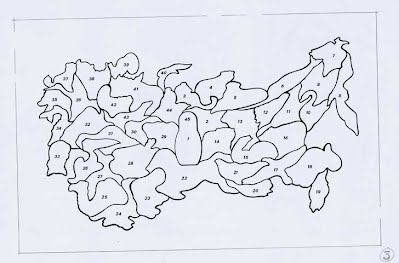 Fig. 8. (a) Design Drawing, (b) Silhouette Drawing, (c) Press clipping from The Sydney Morning Herald, Saturday, May 29, 1999 9. Dreaming, 1992, 24 Pieces 1 Aborigine, 2 Wainigi, 3 Glider, 4 Ring-tail Possum, 5 Cassowary, 6 Humpback Whale, 7 Koala, 8 Pelican, 9 Platypus, 10 Lyrebird, 11 Wombat, 12 Penguin, 13 Numbat, 14 Echidna, 15 Sealion, 16 Tortoise, 17 Dingo, 18 Kookaburra, 19 Hammerhead Shark, 20 Kangaroo, 21 Fruitbat, 22 Black Swan, 23 Crocodile, 24 ButterflyAgain, among the animals, is the Aborigine taking centre stage, among 24 other indigenous animals. The title directly relates to Aboriginal beliefs. Dreaming (also The Dreaming, The Dreamings and Dreamtime) is a term devised by early anthropologists to refer to a religio-cultural worldview attributed to Australian Aboriginal beliefs. 10. Brolga, 1999, 20 Pieces 1 Man, 2 Emu, 3 Brolga, 4 Gliding Squirrel, 5 Eagle, 6 Cockatoo, 7 Magpie, 8 Dingo, 9 Seal, 10 Tortoise, 11 Kookaburra, 12 Dolphin, 13 Lyrebird, 14 Water Hen, 15 Kangaroo, 16 Koala, 17 Bandicoot, 18 Crocodile, 19 Seashell, 20 Flying Fox The reason for the title, unlike other puzzles, is a little unclear. Brolga is a crane of the bird family and is but just one animal in a 20-piece puzzle. There appears to be little reason to specifically title the puzzle in this way. Again, there is an Aborigine, more or less centre stage. Fig. 10. Design Drawing11. Australian Birds Puzzle, 2001, 10 Pieces 1 Eagle, 2 Kookaburra, 3 Cassowary, 4 Penguin, 5 Spoonbill, 6 Tawny Frogmouth, 7 Lyrebird, 8 Owl, 9 Brolga, 10 Cockatoo In contrast to the generic animals above, here the leitmotif is of native Australian birds only. 12. Standing Puzzle, 2002, 9 Pieces 1 Wave with Dolphins, 2 Ring-tailed Possum, 3 Lyrebird, 4 Koala, 5 Platypus, 6 Wombat, 7 Frill Neck Lizard, 8 Kangaroo, 9 Emu Australian animals designed as a standing puzzle, the only such instance of its type. This puzzle then marks the end of the collection. Fig. 12. SilverEssay - 'How our first geographical puzzle came to be'. Recollection of Angiolo Logi, 2016 In February 1979, my wife Ilaria and I arrived in Australia we settled in Sydney and to discover some of the country we decided to take a trip to visit a friend who lived in Maryborough in Victoria. We drove an old, nth generation Panel Van we had just bought; on the way there we had taken the leg from Sydney south on the beautiful coastal road that passes beaches, coves and capes and cuts through beautiful forests of columnar spotted gums. In those days, far from the big cities there was very little traffic and there were kangaroos and emus running in herds along the way before diving back into the countryside. We were impressed by the incredible number of birds of all kinds that took flight as we passed, and finally, in the Grampians, we were able to discover many placid koalas through the leaves of tall eucalyptus trees. The return took us through the arid interior: Mildura, Canberra, Yass, Goulbourn, Sydney, and everything we saw was fascinating. We realized that staying in populated areas, we were confined to a thin strip of coastline with few cities that were the only ganglia of human activity: all around was the void of the oceans, and inside another void made of wind, hot stones and red dust, of which the only thing we knew was that there were strange plants and improbable animals. We felt ourselves in a precarious balance between these two 'voids', we needed something to lean on, and, since I am an architect and I can draw, Ilaria asked me to try to put together a 'puzzle' of the kind of the great Dutch graphic artist M.C. Escher, but made of Australian animals. She wanted this to be a project for her silver work and composing the design of this 'puzzle', I thought to contain it within the silhouette of Australia. Thus, I traced its unmistakable geographical shape and began to cross it with faint and uncertain lines which, like the 'Songlines' of the aboriginals, crisscross the empty space of the continent. Slowly, adjusting and retouching, moving and deleting, those lines found their sense and the images began to emerge. The first was that the central aboriginal man leaning on his didgeridoo in a contemplative rest, then in the background, marsupials, birds, fish and reptiles, gradually defined their positions in a dynamic interpenetration which symbolizes the continuity of the real-world ecological carpet. Finally, the whole silhouette of the continent was filled with the 'characters' of this land. Ilaria rendered the individual pieces with hard wax which she then lost wax cast in silver. She worked on the metal with a chisel, file and brush until she felt that every detail was as it should be and when all the pieces were joined together and formed the shimmering outline of the Australian continent, the result appeared to us to be of dizzying splendour: we took a step back from to distance ourselves and it immediately found its identity and took its own name: AUSTRALIA PUZZLE, our first "Geographic Puzzle". This "object" is not so much a 'dilemma' as the word 'puzzle' would imply, but rather suggests the 'solution' of the modern ecological dilemma of living in harmony with nature. When we showed it around, people of varied education and tastes were so fascinated that some even asked us for iterations made of solid gold. The theme of the contiguity of natural forms that comprise the real ecological environment became our research; Ilaria read complex theoretical texts on creativity which she then explained to me while at the drawing board I was composing for her drawings of Australians 'geographical puzzles'. The Escher compositions take place in a geometric division of a plane, they are typically contained within a rectangle and are made of complementary images of fantastic creatures depicted in a Nordic 'Gothic' style. Our 'Puzzles' are much less severe and have a fluid pattern that develops with the continuity of animal bodies in their realistic dynamic lives to occupy the interior of Australia's geographic silhouette. The silver pieces have a pleasant tactile value, but are not very good in photography, which is why along with their photos we also present their design drawings, the details of which are more perceptible. Thus “the whole is greater than the sum of its parts”, but the one that gives true meaning is the central figure of the man, for he has caused irreversible changes in the environment, and for better or for worse, he is now responsible for what is happening to it. We then went on to design and produce silver puzzles for more than twenty years, but we stopped working in 2002 because unfortunately Ilaria became ill and passed away in early 2009. One month ago, (October 2016) my son Lorenzo was contacted by an English gentleman, Mr. David Bailey, who is devoted to the collection of contemporary designs made of complete elements, which he called "Cluster Puzzles", which in turn sometimes combine to form the geographic silhouette of a country. There are also some done with the Australian profile, which until then I thought was our 'exclusive', and the first of these was made in 1905. In fact, until then, apart from historical cases such as Arcimboldo and Escher, I had never heard of this kind of 'Cluster Puzzles'. I will send to Mr. Bailey many of our 'Cluster Puzzles' which are a dozen or so, so that between all of these we can inspire each other reciprocally. The detail given is very interesting and revealing. Like most people, the Logis worked on the concept in isolation of other people doing this kind of work, with Angiolo unfamiliar with other instances, even in his own country. Admittedly, this was in pre-internet days, of which finding other instances would have been next to impossible without any official designation. Indeed, even today, it is not easy to find such puzzles (hence my campaign to give a description of ‘cluster puzzles’, as detailed on the generic page). Of note is the Escher reference, of Plane Filling I, of whom they were aware, and can be said to at least underlie these. The puzzles vary in being of true tessellation, with a slight ‘rounding off’, and so leaving gaps to greater or lesser degrees. However, these are indeed are based on tessellation principles, and any rounding off is most minor. Here, the main aim is of the veracity of animal portrayal, rather than allowing these to be too distorted by adhering to the strictest tessellation premise. In short, they use the premise, but as stated, in a more ‘fluid’ manner. Even to the tessellation purist such as myself, I have no qualms about this. From the above, one can also see a strong ecological aspect and concern underlying the puzzles, which is gratifying. However, the concept is not unique. There are other instances. For other country (and continent) themes, also see: George Luck, Adam Laurance. Of note is that Laurance also shows Australia. Table of Puzzles Notes ¹ Dates are queried at times, as different ones are given in the book and the general literature, brochures etc. That given in the table is as taken from the book. Other sources give: Southern Cross 1982, Fauna America 1982. P.43, Land and Seas, 1985, Japan 1986. ² Brolga is a bird in the crane family ³ Some of the puzzles were not realised in metal but left at the concept stage, which complicates an all-inclusive inventory. Should these be included, or detailed separately? There appears to be no one right or wrong approach. Therefore, to give a better all-round impression, I have decided to include such examples in the listing. Conclusion I like these puzzles very much indeed. An obvious attraction is the unfailing dedication to a theme. Although there is nothing ‘wrong’ with a cluster puzzle of non-themed instances, such a premise can be said to ‘elevate’ the genre. The artwork is most pleasing. Although not all are strictly recognisable in silhouette, this is due to the presentation of the animal, in that the viewpoint is of a three-quarter view for instance. There are many pleasing design solutions. Further, the (typically) high number of pieces is most impressive. Again, evidence of quality, in that a double contour is more obvious, as this is not required on others’ work of just a handful of pieces. Overall, there is much here to be impressed about. Such a relative abundance of works, and the number of pieces thereof, of good quality artwork, of a challenging specific themed nature, countries, is thus indicative of excellent quality work, which is indeed the case here. A feature of the puzzles, not generally seen in other cluster puzzles, is of the third dimension. Overall, I am most impressed with these; a challenging subject (a specific country), with overwhelmingly good articulations and relatively high number of pieces, not to mention the two innovations of their own devising. Well done all-round, Angiolo! References Perhaps surprisingly, there is relatively little recognition in print, with books and newspapers. Indeed, so far as I am aware of, there is not a single reference to the puzzles in any book, save for the book by Logi himself! And in the newspaper, there are just but six references, with only a few in-depth treatments. I can assure you, this is disproportionate as to the quality of the puzzles, and does not do them justice in any way! Books Ravenna, Daniele (Text), editorial coordinator Linda Fox. Australia Puzzle. Contemporary Silverware & Jewellery. Puzzle Pty Ltd, 1994, 57 pp. An absolute delight for the cluster puzzle enthusiast! This is best described as a coffee-table style book. However, the organisation of the book is a little curious in various ways; there is no introduction, contents or index as such, and the page numbering is not always shown. Although basic details as to date, sizes etc. are given, there is not an inventory. The book has many gatefolds. It is largely a picture book, although throughout, there is text. The focus, not unnaturally is primarily on the puzzles, although not all are included. These include The Discovery of Australia pp. 10-11, The First Black Swan pp. 14-15, The Southern Cross pp. 16-17, The Dreaming (Gatefold pull-out) p. 20, Australian Land and Seas (1986); The Japan Puzzle (1989) pp. 42-43. There is also a two-page spread of celebrity interest, pp. 54-55, with the Queen, Michael Jackson and Stevie Wonder pictured with Australia Puzzle. Escher is mentioned pp. 18 and 50.
Newspapers Pollan, Corky. ‘Pieces of State’. New York Magazine, 11 February 1985, p. 54 Wilkinson, Mary. ‘Just a small mink will do, thanks’. The Sydney Morning Herald, Tuesday December 6, 1983, p. 4 Foster, Susie. ‘Puzzles add more pieces’. The Sydney Morning Herald, Thursday August 9, 1990, p. 20 Johnson, Judy. ‘Ilaria & Angiolo Logi’. The Sydney Morning Herald, Sunday September 2, 1990, pp. 10-11 A double-page, dedicated spread. A general discussion, with a mention of the Australia puzzle. Anon. No Title. Column 8. The Sydney Morning Herald, Saturday, May 29, 1999 On the chance President Gorbachev interaction and USSR puzzle. GL. ‘From Cape to Tassie, gold gumnuts’. The Sydney Morning Herald, Tuesday, 31 July 1984 (Gumnuts are the hard woody fruit of trees of the genus Eucalyptus) Acknowledgments Angiolo Logi, despite ill health, for his encouragement in my task in documenting his work. Lorenzo Logi, for his most enthusiastic response to my initial query, and for assembling much additional material from the family archives. Page History 2020 2016 (Generic page addition) 2015 (Generic page addition) Dedicated Page Created 20 July 2020. Additional workings 21-24, 27-29 July. |
Cluster Puzzles >
